Hollerith 1890 Census Tabulator and the evolution of the IBM punch card
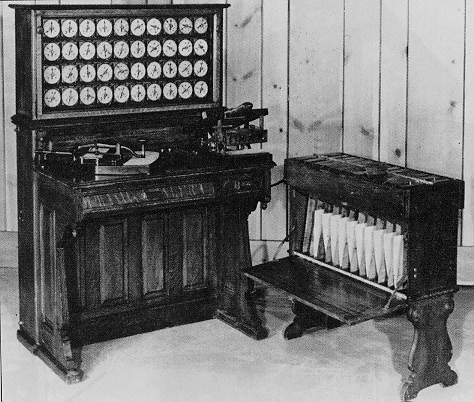
|
| Photo: IBM. |

Images:
[103]; CLICK to enlarge.
Left to right: The circuit-closing press ("card reader"); diagram of press; hand insertion of card into a sorter compartment that opened automatically based on the values punched into the card; tallying the day's results. "Each completed circuit caused an electromagnet to advance a counting dial by one number. The tabulator's 40 dials allowed the answers to several questions to be counted simultaneously. At the end of the day, the total on each dial was recorded by hand and the dial set back to zero [103]."
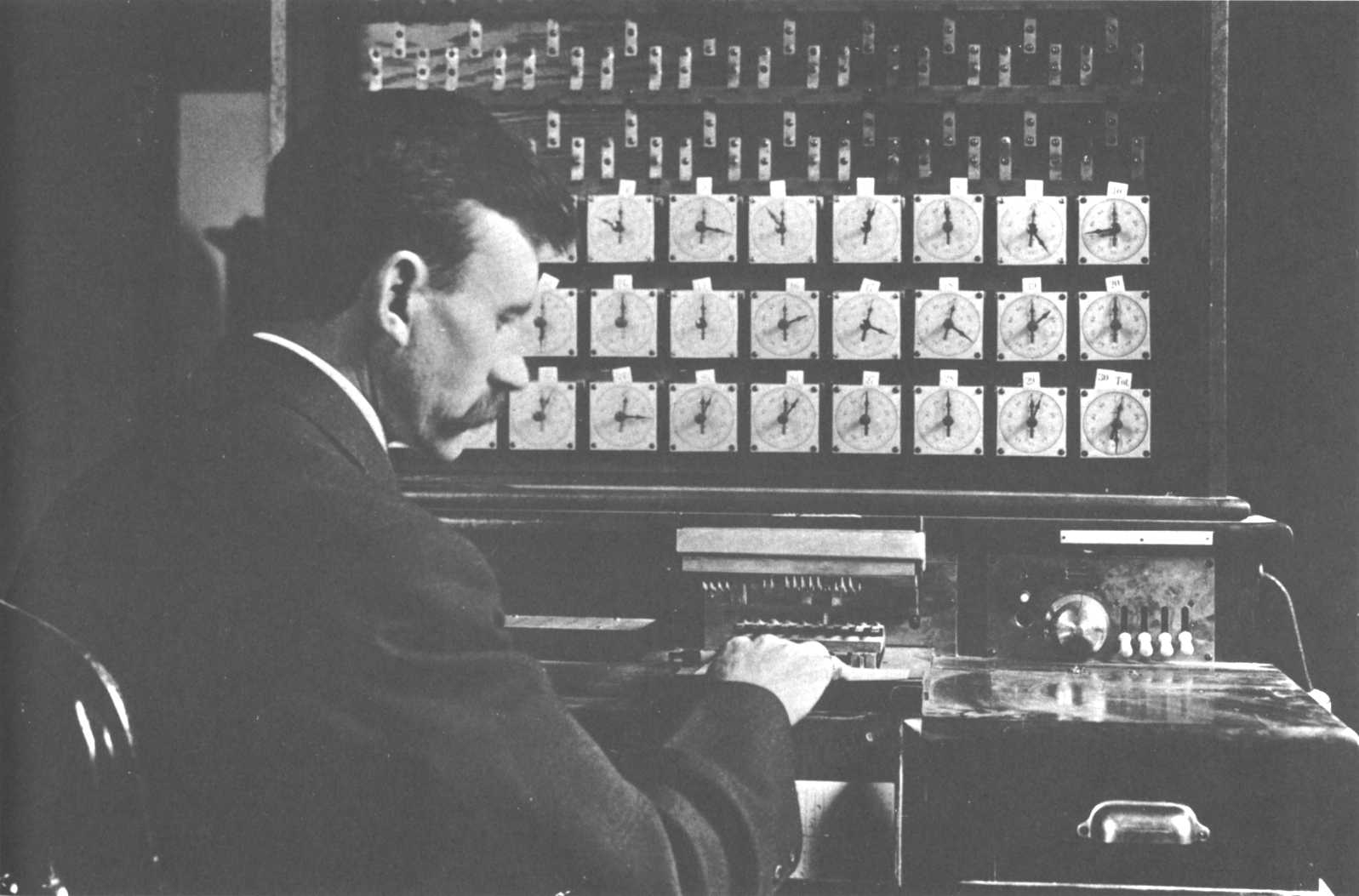
–The Electrical Engineer,
11 Nov 1891.
The 1890 tabulator was capable only of counting. Subsequent models, developed by Hollerith himself, were also able to add, thus broadening their scope to accounting, warehousing, and shipping applications. Between 1902 and 1905, Hollerith also developed an automatic card feed and a method for reading cards in motion and settled on a standard card format. In 1928, IBM produced its first tabulator (the Type IV) with both addition and subtraction capability.
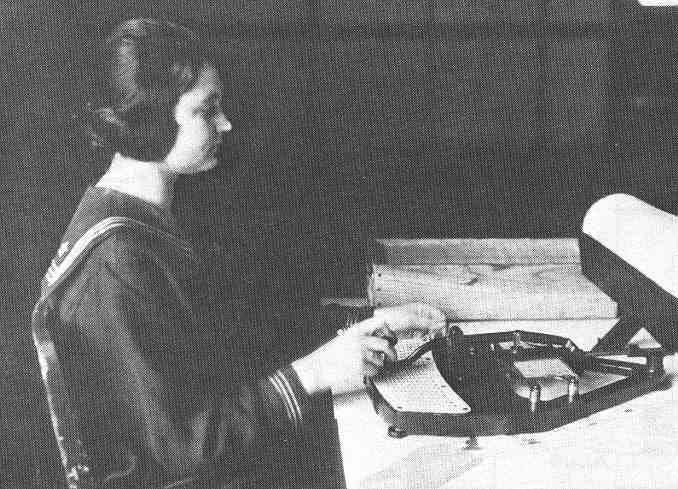
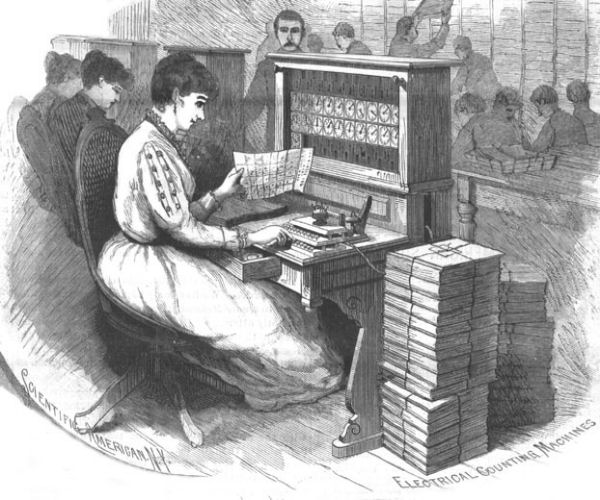
Left: The Pantographic card punch in operation. The operator holds the stylus over the template. The card is in the punch station above the template. Right: After the cards are punched, they are fed into the Hollerith tabulators.
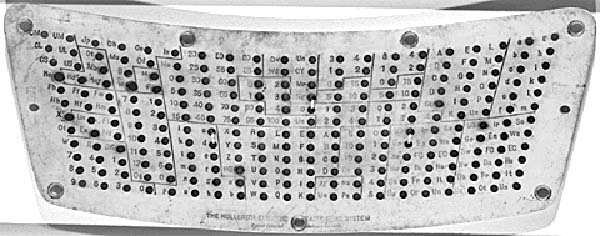
Above: A punch-card template from a Pantographic punch used the 1890 US census (image: US Library of Congress). Notice there are 12 rows (as in modern punch cards), of which only the bottom 10 were used, and only 20 columns; the curved shape is due to the Pantographic mechanism, an early ergonomic device allowing operators to punch 500 cards per day with good accuracy and minimal physical strain (compared to the handheld "train conductor" punches used in previous trials, which could cause near paralysis with prolonged use -- carpal tunnel syndrome did not start with PCs! -- and with which correct placement of holes was problematic). The Pantographic punch operator positioned a stylus over the desired hole in the template and pressed it to punch a hole in the corresponding position of the rectangular card. The template has areas marked off for various demographic categories.
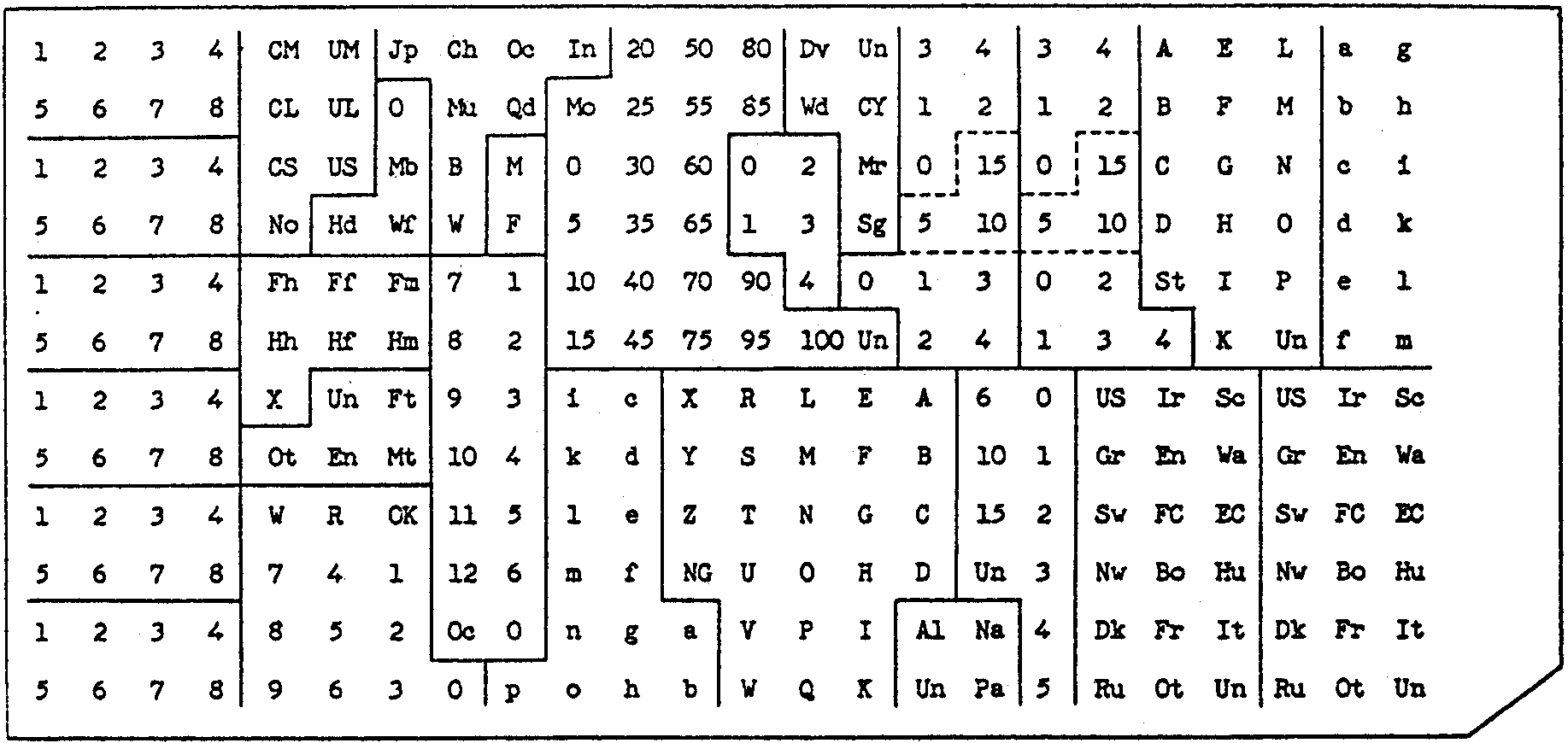
Above: The "reading board" for a punched card from the 1890 census (the cards themselves were blank; this is like the "decoder ring" for the holes, which itself needs a second "decoder ring" to decipher the alphanumeric codes). Cards had one one corner cut diagonally to protect against upside down and/or backwards cards that might not otherwise be detected and the reading board had the same cut for obvious reasons. The card measures 3.25 by 7.375 inches... (image and dimensions from Aspray, Computing Before Computers[69]).
On 16 August 2023, I received the following email from Keith Elkin:... the same size as the 1887 US paper currency because Hollerith used Treasury Department containers as card boxes (pictures not actual size, but all to the same scale):Aurora Tucker, the collections Manager at the Computer History Museum in Mountain View, California went out of her way and took measurements of their 1890 Hollerith pantograph. I thought I should pass this on to ensure that the actual values become part of the historical record. This gives the possible size of the Hollerith punch card in 1890.
(Aurora Tucker) I am pleased to share the following measurements:
- The width (widest card dimension) is 6 5/8 inches, which can be expanded by a maximum addition of 3/8 inches if the spring arm is fully extended.
- The depth (shorter card dimension) is a static 4 ¼ inches.
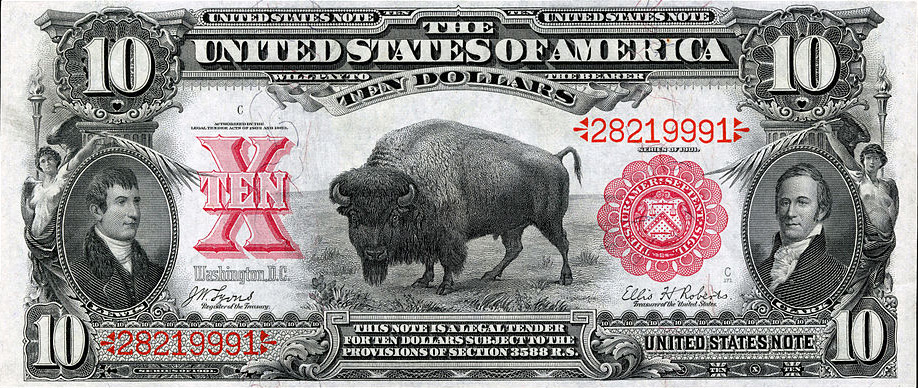
US banknotes were reduced in size by 20% to their present dimensions in 1928:
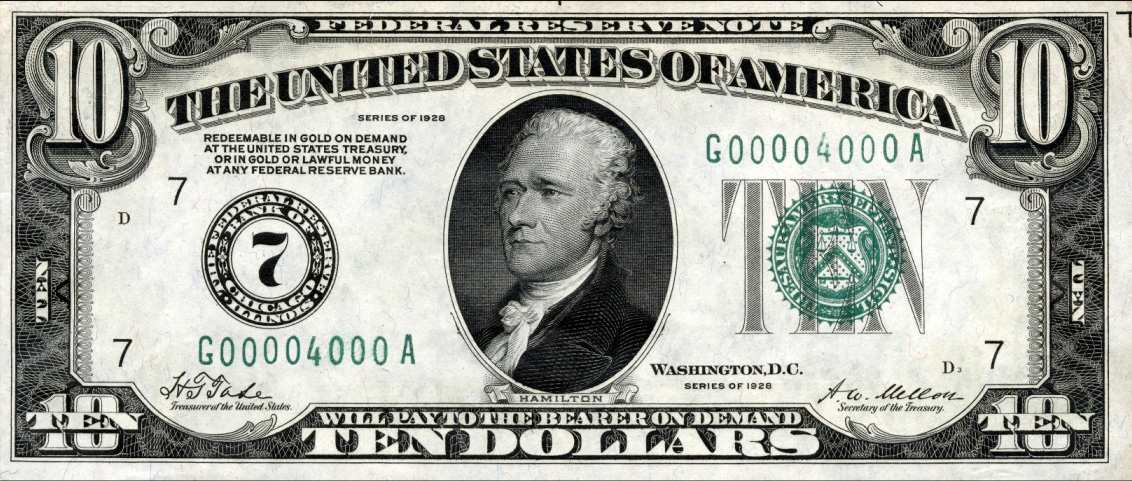
Using round holes, the card column density eventually reached 45 prior to the 1928 80-column rectangular-punch standard. Here is the modern (or at least, final) standard, corner-cut, 80-column general-purpose IBM punch card, introduced in 1928, and popularly known as the "IBM card":
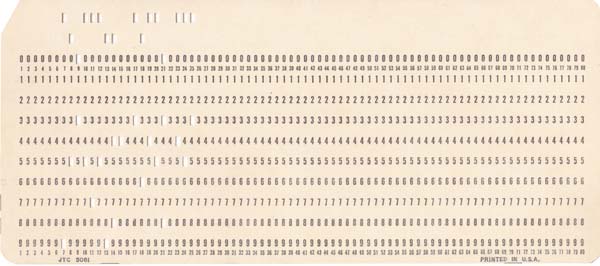
- The Hollerith Machine, United States Census Bureau website, accessed 16 April 2021.
- 1890 Census: The Meaning of the Hollerith Card Codes, earlycomputers.com, accessed 16 April 2021.
- "The Hollerith Method of Statistical Tabulation", Frank Leslie's Illustrated Newspaper, October 12, 1889, p.182.
- Scientific American, Vol.63, No.9, August 30, 1890.
- Martin, T.C., "Counting a Nation by Electricity", The Electrical Engineer, New York, Vol.12, November 11, 1891, pp.521-530.
- "Hollerith's Electric Tabulating Machine", Railroad Gazette, 19 April 1895.
- Austrian, Geoffrey, Herman Hollerith: Forgotten Giant of Information Processing, Columbia University Press (1982) [44].
- Bashe, Charles J.; Lyle R. Johnson; John H. Palmer; Emerson W. Pugh, IBM's Early Computers, MIT Press (1985) [4]
- Eames, Charles and Ray, A Computer Perspective: Background to the Computer Age, Harvard University Press. First Edition 1973; Second Edition 1990 [103].
- Knuth, Donald, The Art of Computer Programming, Vol.3 "Sorting and Searching", Addison-Wesley (1973); Section 5.5, pp.382-384 [104].
- Pugh, Emerson W., Building IBM: Shaping an Industry and its Technology, The MIT Press (1995) [40]
- Truesdell, Leon E., The Development of Punch Card Tabulation in the Bureau of the Census 1890-1940, US Government Printing Office, Washington DC (1965).
- Destruction of the 1890 Census, Newspapers.com, accessed 20 October 2019. The story of how the 1890 records (including forms and cards) were destroyed in 1932, before the National Archive was established.
- The Punched Card Tabulator, IBM 100: "Herman Hollerith's first tabulating machines opened the world's eyes to the very idea of data processing. Along the way, the machines also laid the foundation for IBM..."
- Herman Hollerith.
- Tabulators.
- Sorters.
- To see a modern card with interpreted punches, CLICK HERE.
- To see a selection of early Hollerith and IBM card punches, CLICK HERE.
- To see IBM key (card) punch machines from the height of the punched-card era, CLICK HERE and HERE.
- And: Punched Cards - A brief illustrated technical history, Douglas W. Jones, University of Iowa. And THIS SITE.
Translations of this page courtesy of...
| Language | Link | Date | Translator | Organization | |||||||||||||||||||||||||||||||||||||||||||||||||
|---|---|---|---|---|---|---|---|---|---|---|---|---|---|---|---|---|---|---|---|---|---|---|---|---|---|---|---|---|---|---|---|---|---|---|---|---|---|---|---|---|---|---|---|---|---|---|---|---|---|---|---|---|---|
| Finnish | Suomi | 2023/08/31 | Kerstin Schmidt
| French
| Français
| 2023/08/25
| Kerstin Schmidt
| prothesiswriter.com
| Georgian
|
ქართული
| 2019/08/20
| Ana Mirilashvili
| LPA Code Professional
Scientific Translations
|
Italian
| Italiano
| 2023/08/31
| Kerstin Schmidt
| https://admission-writer.com/
| German
| Deutsch
| 2023/08/25
| Kerstin Schmidt
| writemypaper4me.org
| Norwegian
| Norsk (bokmål)
| 2022/08/11
| Rune
| Bildeler på nett
| Polish
| Polski
| 2023/08/25
| Kerstin Schmidt
| justdomyhomework.com
| Romanian
|
Română
| 2023/08/17
| Vladyslav Byshuk | Владислав Бишук |
skyclinic.ua
|
Russian
|
Русский
| 2023/08/17
| Vladyslav Byshuk | Владислав Бишук |
studybounty.com
|
Spanish
| Español
| 2023/08/31
| Kerstin Schmidt
| https://pro-academic-writers.com/
| Ukrainian
| Українська
| 2023/08/17
| Vladyslav Byshuk | Владислав Бишук |
studycrumb.com
|
|